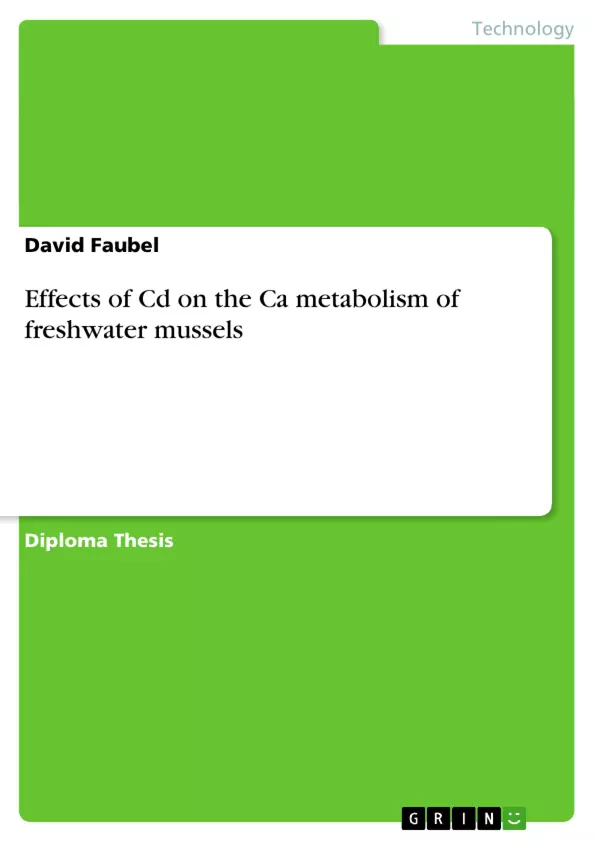To achieve a better understanding of how cadmium interferes with the calcium metabolism of freshwater mussels, four cadmium exposure experiments were performed with the freshwater clam Anodonta cygnea. Separate experimental groups were treated with vitamin D3 and SEA0400 (a selective inhibitor of sodium-calcium exchangers) to compare the effects cadmium has with those of other substances influencing the calcium metabolism. Tissue and body fluid samples taken from the animals were analysed for cadmium, calcium and other ions of physiological importance, in order to elucidate the calcium transport processes. The osmolarity of the body fluid samples was also measured.
Inhaltsverzeichnis (Table of Contents)
- 1 Introduction
- 2 Material and methods
- 2.1 Animals
- 2.2 Materials
- 2.3 Cleaning of equipment for sample storage
- 2.4 Exposure experiments
- 2.5 Analysis of body fluids
- 2.5.1 Sampling
- 2.5.2 Sample analysis
- 2.6 Analysis of soft tissues
- 2.6.1 Sampling
- 2.6.2 Sample preparation
- 2.6.3 Sample analysis
- 2.7 Data preparation
- 3 Results
- 3.1 Element distribution
- 3.2 Treatment effects
- 3.2.1 Treatment with Cd
- 3.2.2 Treatment with vitamin D
- 3.2.3 Treatment with SEA0400
- 3.3 Correlation between Ca and Cd
- 4 Discussion
- 4.1 Quality control
- 4.2.1 Troubleshooting
- 4.2 Tank water pH and temperature
Zielsetzung und Themenschwerpunkte (Objectives and Key Themes)
This diploma thesis investigates the effects of cadmium (Cd) on the calcium (Ca) metabolism of freshwater mussels. The main objective is to understand how Cd exposure impacts Ca uptake, distribution, and regulation in these organisms.
- Cadmium toxicity and its effects on freshwater mussels
- Calcium metabolism and its regulation in freshwater mussels
- The impact of Cd exposure on Ca uptake, distribution, and regulation
- The role of vitamin D and SEA0400 in mitigating Cd effects on Ca metabolism
- Correlations between Cd and Ca levels in different tissues and body fluids
Zusammenfassung der Kapitel (Chapter Summaries)
This diploma thesis examines the effects of cadmium (Cd) on the calcium (Ca) metabolism of freshwater mussels. It investigates the distribution of Cd and Ca in different tissues and body fluids, as well as the impact of Cd exposure on Ca uptake, distribution, and regulation. The study explores the role of vitamin D and SEA0400 in mitigating Cd effects on Ca metabolism and investigates correlations between Cd and Ca levels in different tissues and body fluids. The work presents experimental procedures, results, and a discussion of the findings.
Schlüsselwörter (Keywords)
This work focuses on the impact of cadmium (Cd) on the calcium (Ca) metabolism of freshwater mussels. It investigates the distribution of Cd and Ca in various tissues and body fluids, the effects of Cd exposure on Ca uptake and regulation, and the potential mitigating effects of vitamin D and SEA0400. Key concepts include metal toxicity, bioaccumulation, Ca homeostasis, and environmental toxicology. This research contributes to the understanding of the ecological consequences of heavy metal contamination in freshwater ecosystems.
- Citation du texte
- Dipl.-Geoökologe Univ. David Faubel (Auteur), 2005, Effects of Cd on the Ca metabolism of freshwater mussels, Munich, GRIN Verlag, https://www.grin.com/document/77262



